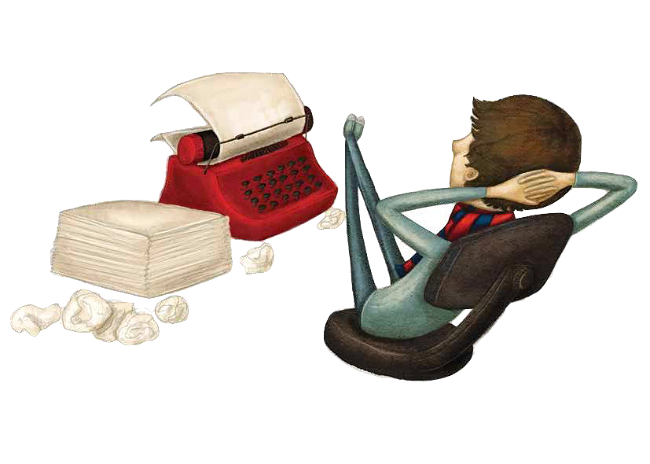Step by Step Guide to Writing a Children's Book
May 27th, 2020
1. PERFECT THE PLOT
If you start with a bang, you wonʼt end with a whimper. – T.S. Eliot
Perfecting the plot of your story is vital. It must have a defined beginning, middle and end. No matter the size, one must be able to pinpoint the rise and fall of events like a rickety rollercoaster ride. The beginning is the ascent of the rollercoaster. It is here that the writer must catch the readerʼs attention and interest. The middle consists of the highest point on the ride or a series of loops. At this point, the story must reveal one or more climactic events as they take place. These can be as perilous as a runaway roller-coaster or as subtle as a shift in perspective, as long as the reader is left clinging to every word, like he would to a runaway rollercoaster cart. The end is the final descent of the ride whereby it comes to a neat and not-entirely perilous end. Here, the writer must resolve the main climactic events in a satisfying and conclusive way.
2. SHOW, DONʼT TELL
Don't tell me the moon is shining; show me the glint of light on broken glass. – Anton Chekhov
If Monty is a magnificent magician, donʼt simply write Monty is a magnificent magician. This is telling. Instead, show the reader that Monty is a magnificent magician through description. Let the reader hear the cheer of the audience and feel Montyʼs confidence. Take us into his mind as he expertly produces a card out of thin air. Take us into the mind of the audience as they try to spot hidden doors in the floor. Show the reader. Donʼt tell.
3. AVOID CLICHÉ … LIKE THE PLAGUE
Easy writing makes hard reading. – Ernest Hemingway
Think about the words you write and try to avoid clichéd expressions and descriptions. It may take a little longer to formulate your sentences, but you will find using your own words beneficial as a writer, and a marked improvement in the quality of your written work.
4. ADD METRE TO YOUR RHYME
So the writer who breeds more words than he needs, is making a chore for the reader who reads.– Dr Seuss
Rhyming texts must have metre. A story that rhymes but lacks metre is akin to singing off key. Each line should have a pattern of stressed and unstressed beats. Be sure to count the syllables when constructing your rhyming text and avoid the easy rhyming word. The words you use should also move your story forward.
The Commissioning Editor's Storytelling Tip
Treat your story like a thriller. No matter what it is about, or how long it is, there must be something in it that a reader will find thrilling.
Resources and Networking
There are so many great resources available for aspiring and working writers within the industry. Why not get involved today? They are also great environments for networking.Alliance of Independent Authors:
https://www.allianceindependentauthors.orgWriters & Artists:The Society of Children's Book Writers and Illustrators:
https://www.scbwi.orgFederation of Children's Book Groups:
http://www.fcbg.org.uk/blog/The Society of Authors:
https://www.societyofauthors.orgNeed some extra support?
Get involved in National Novel Writing Month (NaNoWriMo) and write an entire novel in a month. Track your progress and meet other professional and amateur authors online at www.nanowrimo.orgSet yourself some writing challenges and get inspired at: https://thewritepractice.com.
Comments (0)
No comments have been submitted yet.
Why not be the first to send us your thoughts
Leave A Comment
Thank you for your comments,
they will appear shortly once approved.
TOPICS
RECENT POSTSHAVE YOU SEEN...1
Meet Wendy Goucher, author of Eesha and the Mud Monster MysteryMarch 11th, 20242
Ride the latest wave with Samantha Bell, author of The Girl Who Saved the Ocean.April 21st, 20233
Behind the Story and Illustrations of The Great Guinea Pig Adventures with Hollie SmithFebruary 23rd, 20224
Behind the Illustration Process of Karma and Koo with Emma StuartDecember 16th, 20215
Inside the Inspiration for The Great Guinea Pig Adventures with Hollie SmithNovember 24th, 20211
Meet and Greet - Introducing the Kids to Your Partner for the First Time by Rachel BraceJuly 28th, 20212
Top Tips on How to Write a Junior Fiction/Middle Grade BookJuly 30th, 20213
Meet Chi Mary KaluOctober 29th, 20194
Get to Know Beverly Jatwani, Author of Pedro the Puerto Rican Parrot!May 5th, 20215
Inside the Inspiration for The Great Guinea Pig Adventures with Hollie SmithNovember 24th, 2021